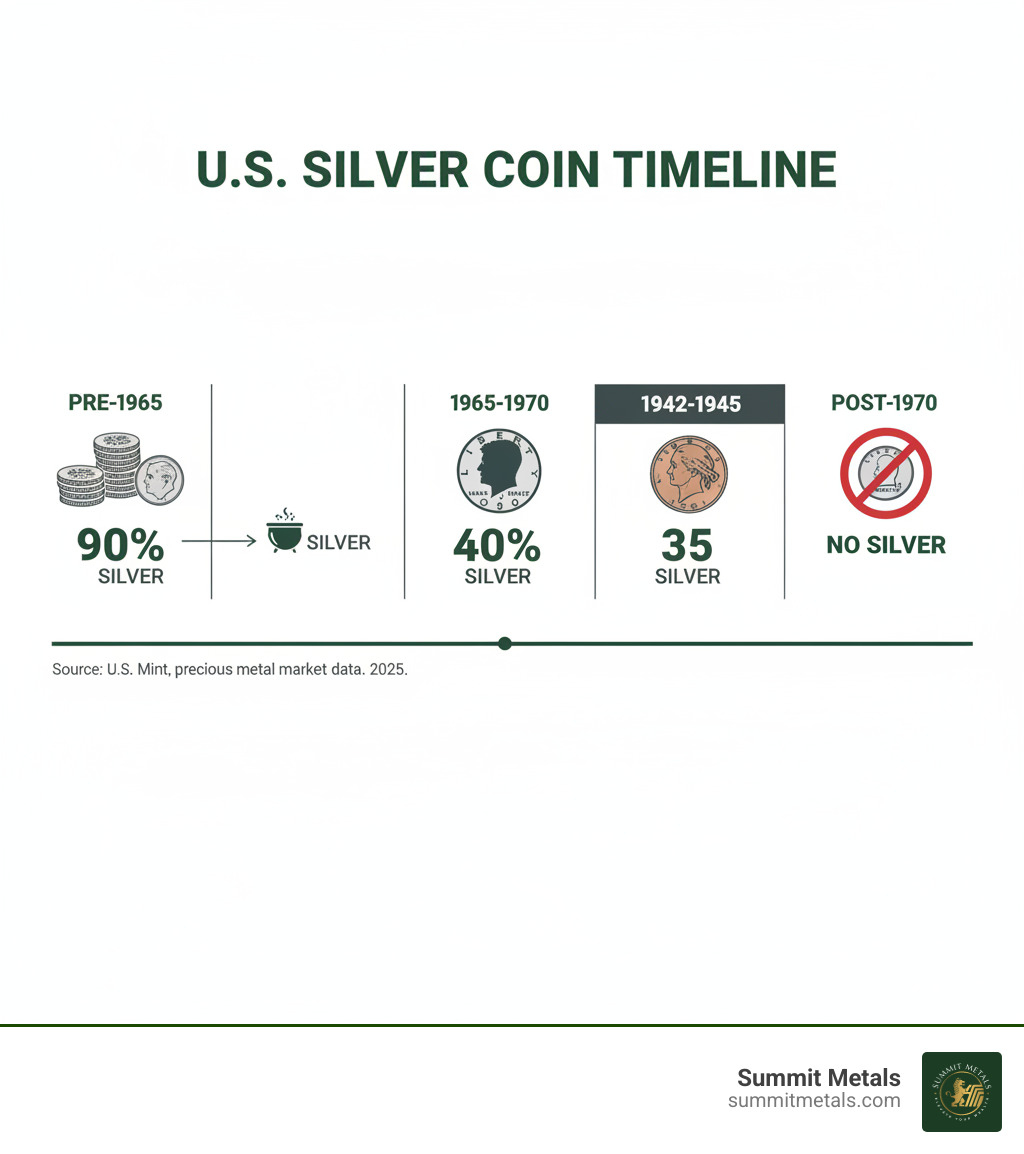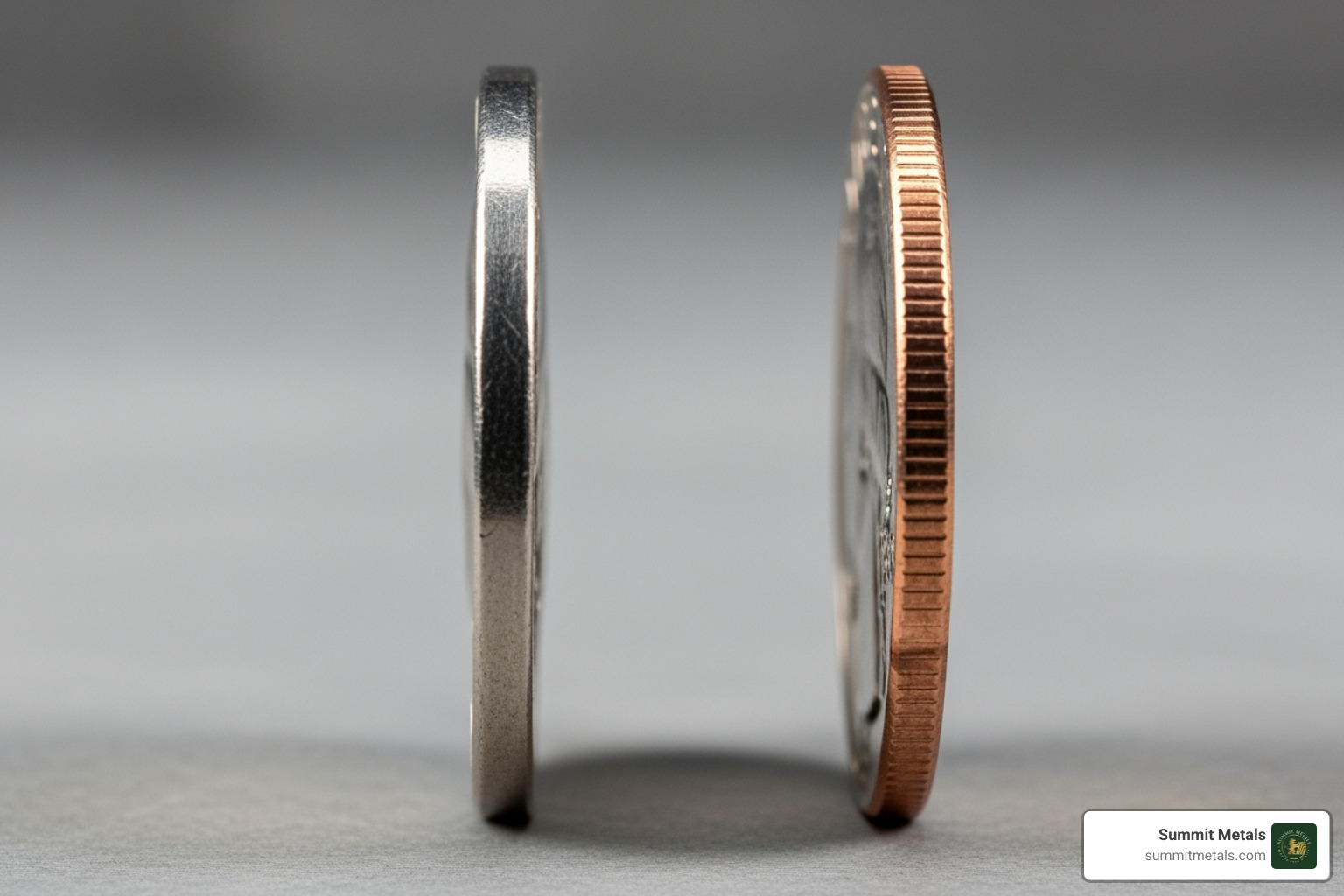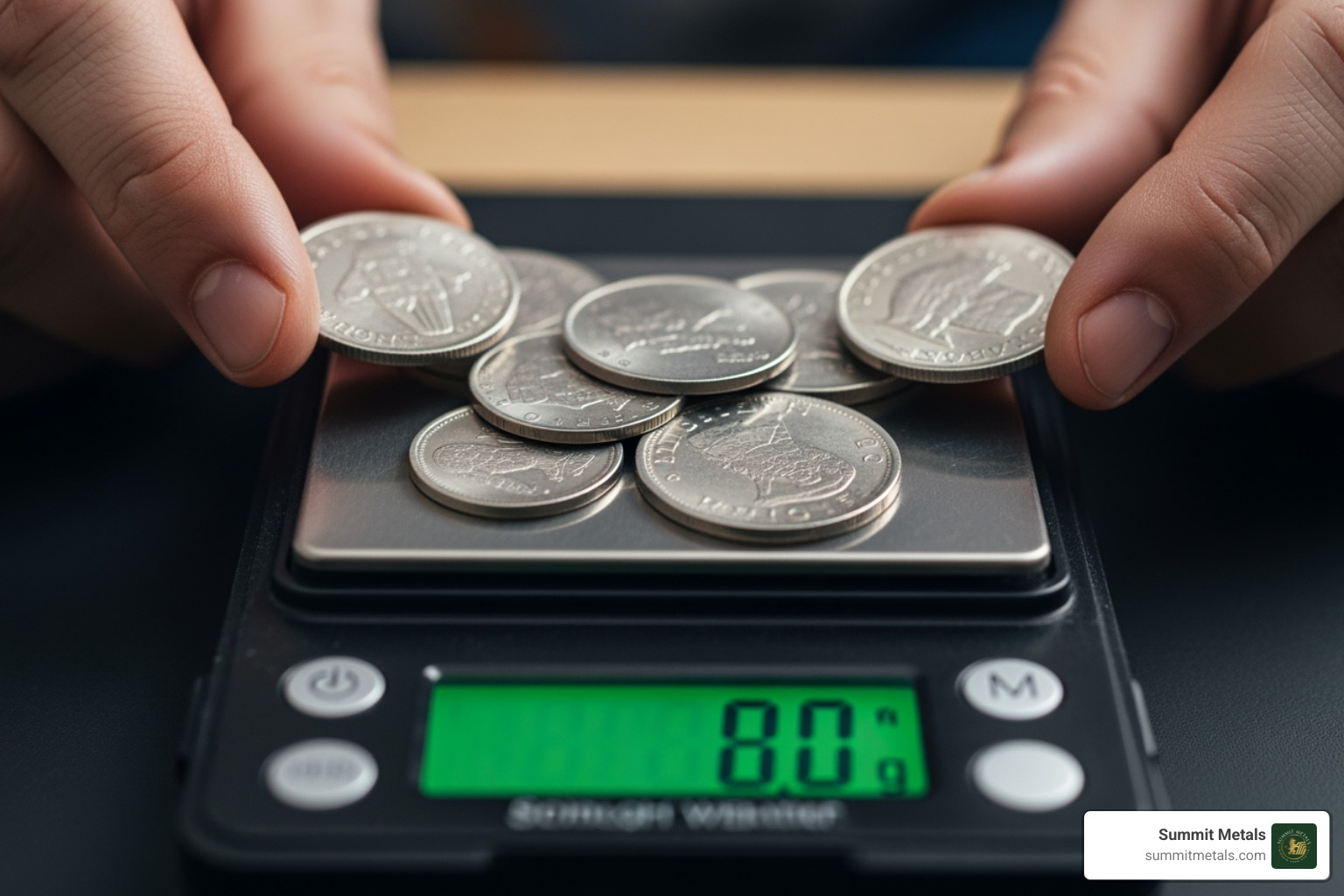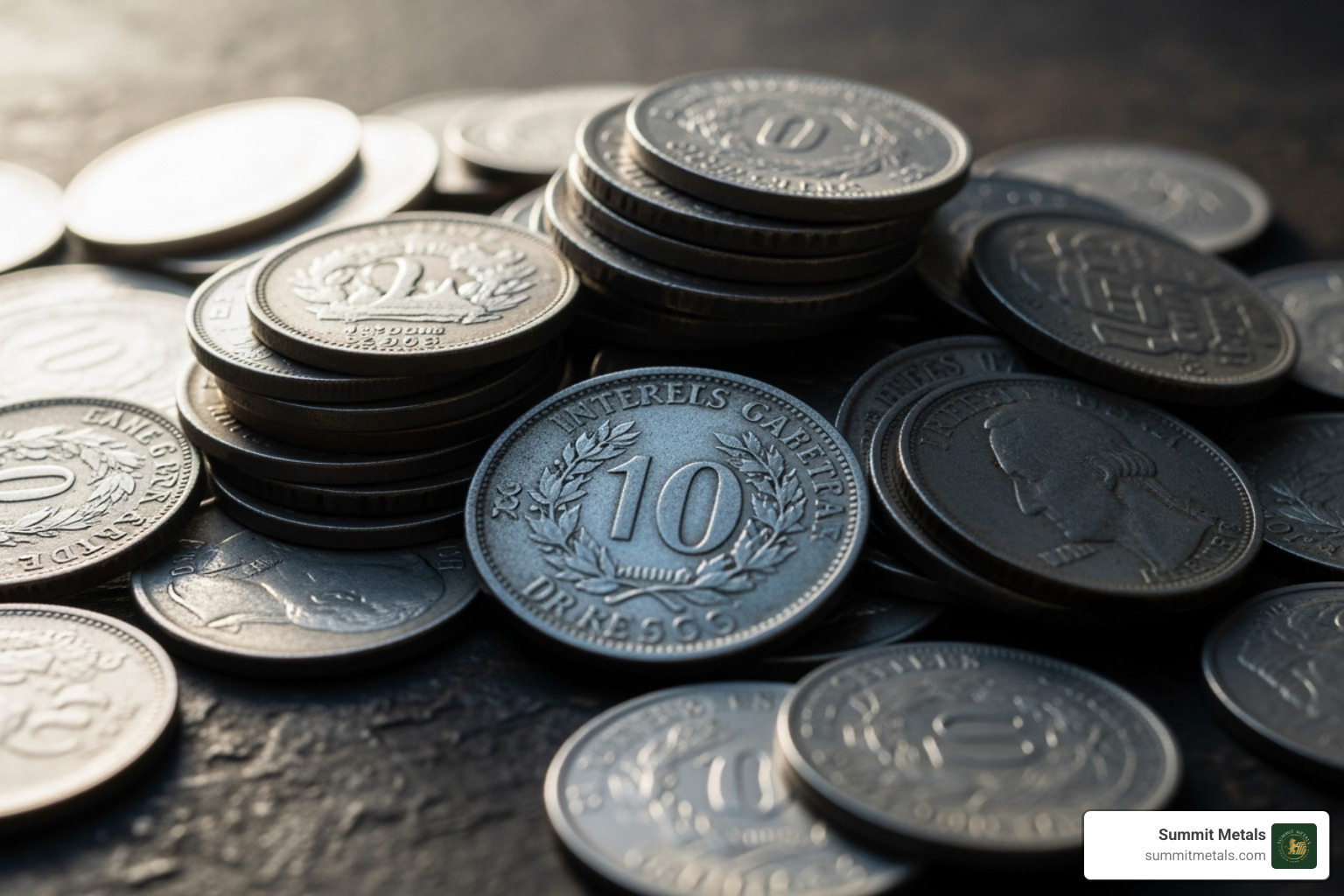From Pocket Change to Precious Metal
Scrap silver coin value is the intrinsic worth of old U.S. coins based on their silver content, which is often far more than their face value. Here's a quick look at what your silver coins could be worth:
Quick Silver Coin Values (at recent silver prices):
- Pre-1965 Dimes: ~$2.25 melt value
- Pre-1965 Quarters: ~$5.63 melt value
- Pre-1965 Half Dollars: ~$11.25 melt value
- Silver Dollars (1878-1935): ~$24.06 melt value
- War Nickels (1942-1945): ~$1.75 melt value
Prices shown are at the time of this publication.
That old quarter in your drawer isn't just 25 cents. If minted before 1965, it contains 90% silver, making it worth over 20 times its face value at today's prices.
This difference illustrates Gresham's Law: people hoard more valuable money and spend the less valuable. When the U.S. removed silver from coins in 1965, savvy individuals began saving these silver coins, recognizing their true worth.
The term "junk silver" might sound dismissive, but these pre-1965 coins are an accessible way to own precious metals. Their value comes from silver content, not rarity, making them ideal for investors focused on scrap silver coin value.
I'm Eric Roach. After a decade on Wall Street helping Fortune-500 clients, I learned that understanding intrinsic value is key to building resilient portfolios. Now, I help everyday investors apply those same strategies to protect and grow their wealth with precious metals.

What's in Your Pocket? A Guide to Identifying U.S. Silver Coins
Before calculating the scrap silver coin value of your holdings, you must know which coins contain silver. Not all old coins are silver, and some unexpected ones are. This is your first step in determining their melt value.
For over 170 years, American dimes, quarters, and half dollars were mostly silver, a standard set by the Coinage Act of 1792. This changed with the Coinage Act of 1965. Rising silver prices made coins worth more as metal than currency, so the government removed silver from dimes and quarters and reduced it in half dollars. People quickly began hoarding the older silver coins.
The easiest way to identify silver coins is to check the date. For most U.S. dimes, quarters, and half dollars, 1964 is the last year for 90% silver. After 1965, they generally contain no silver, with a few key exceptions.

A neat trick for dimes, quarters, and half dollars is to look at the edge. Silver coins have a solid silver stripe. Modern clad coins reveal a copper stripe sandwiched between outer layers.
90% Silver Coins ("Constitutional Silver")
These coins are the jewels of scrap silver coin value. Often called "Constitutional Silver," they contain 90% silver and 10% copper for durability.
- Dimes (pre-1965): Includes Barber, Mercury, and Roosevelt dimes. Each has 0.0723 troy ounces of silver.
- Quarters (pre-1965): Includes Barber, Standing Liberty, and Washington quarters. Each has 0.1808 troy ounces of silver.
- Half Dollars (pre-1965): Includes Barber, Walking Liberty, Franklin, and 1964 Kennedy halves. Each has 0.3617 troy ounces of silver.
- Silver Dollars (1878-1935): Includes Morgan and Peace dollars, each with 0.7734 troy ounces of silver.
For deeper insights into these historical treasures, explore more info about Constitutional Silver.
40% Silver Coins
After 1964, the government still used some silver. These coins offer solid scrap silver coin value, though less than their 90% counterparts.
- Kennedy Half Dollars (1965-1970): These contain 40% silver, with about 0.1479 troy ounces of pure silver each.
- Eisenhower Dollars (1971-1976): Most "Ike" dollars have no silver. However, collector versions with an "S" mint mark are 40% silver. These were not made for circulation.
A 1965-1970 Kennedy half dollar has a melt value of around $4.60, while a 40% silver Eisenhower dollar is worth about $9.84 at recent prices.
35% Silver "War Nickels"
During World War II, nickel was a strategic material. From mid-1942 through 1945, the mint produced Jefferson Nickels containing 35% silver, 56% copper, and 9% manganese.
The key identifier is a large mint mark (P, D, or S) above Monticello on the reverse. The "P" mint mark was a first for the Philadelphia mint. These War Nickels contain about $1.75 in melt value each.
Prices shown are at the time of this publication.
How to Calculate the Scrap Silver Coin Value
Now that you've identified your silver coins, it's time to find out what they're worth. Calculating scrap silver coin value turns old coins into tangible wealth, and the math is surprisingly simple.

Melt value is the intrinsic worth of the precious metal in your coin. We're not suggesting you melt your coins, but this calculation reveals their baseline value based on silver content. It's also important to know that precious metals are measured in troy ounces (31.1035 grams), which are heavier than standard ounces (28.35 grams).
The silver spot price fluctuates constantly during market hours. This volatility is why many investors use dollar-cost averaging, buying silver regularly to smooth out price swings. Programs like Summit Metals' Autoinvest service make this strategy simple and automatic.
Understanding the Scrap Silver Coin Value Formula
Every scrap silver coin value calculation uses three key variables: the coin's weight, its silver purity, and the current price of silver. Here's the formula:
Melt Value = (Coin's Silver Weight in Troy Ounces) × (Current Silver Spot Price)
To get the coin's silver weight, you use this: (Total Weight) x (Purity as a decimal). Let's use a pre-1965 Washington quarter as an example. It contains 0.1808 troy ounces of fine silver. If silver is trading at $30 per troy ounce, the math is:
0.1808 troy oz × $30.00/troy oz = $5.42
That 25-cent coin is worth over 21 times its face value! This is why they vanished from circulation after 1965.
Here are the fine silver weights for common U.S. coins:
- 90% Dimes: 0.0723 troy oz
- 90% Quarters: 0.1808 troy oz
- 90% Half Dollars: 0.3617 troy oz
- Silver Dollars (Morgan/Peace): 0.7734 troy oz
- 40% Half Dollars (1965-70): 0.1479 troy oz
- 35% War Nickels (1942-45): 0.0563 troy oz
Finding the Current Scrap Silver Coin Value
The trickiest part of the calculation is getting an accurate, up-to-date silver price. Silver prices change constantly based on economic news, geopolitical events, and industrial demand. You can find the live spot price of silver on most major financial news websites or precious metals dealer sites.
If you have a large pile of mixed coins, calculating the value for each can be tedious. Fortunately, many online silver coin melt value calculators can do the work for you. You simply enter the quantity of each coin type, and these tools use live silver prices to provide an instant, accurate total melt value.
These calculators are also useful for running "what if" scenarios to see how your collection's value might change with the silver price.
The spot price is for raw silver. When buying or selling physical coins, a small premium is added to cover dealer costs. At Summit Metals, we believe in complete transparency. Our real-time pricing system ensures you always know exactly what you're paying, with no hidden fees.
Melt Value vs. Collector Value: Is It Just Scrap?
Here's where things get interesting. While we've focused on scrap silver coin value, some coins are worth far more than their silver content. This is called numismatic value, and it separates ordinary coins from genuine treasures.

A common 1964 Kennedy half dollar is worth about $11.25 for its silver. But a 1916-D Mercury dime in good condition could be worth over $2,000—not for its silver, but because collectors want it.
What gives a coin numismatic value? Rarity is the biggest factor. If few were minted or survived, collectors pay a premium. A coin's condition also matters enormously. A beat-up 1964 quarter is worth its melt value, but an uncirculated one could be worth several times more.
Mint marks (the tiny letter indicating where a coin was made) can also create huge value differences. Certain years are key dates due to low mintage, historical events, or errors.
Here is the most important advice: never clean your coins. Cleaning destroys value faster than anything else. Even gentle polishing creates microscopic scratches that collectors spot immediately, ruining the coin's original surface and patina.
Professional services like PCGS grade coins on a 70-point scale, where a few points can mean thousands of dollars in value. Before selling any coin for its scrap silver coin value, research its date, mint mark, and condition. When in doubt, consult a reputable dealer.
The beauty of silver coins is their intrinsic metal value provides a solid price floor. Even with zero collector appeal, you still have the silver. But occasionally, you might find your "junk silver" is a numismatic treasure.
For more detailed information, you can learn about coin grading from PCGS. Their expertise can help you spot the difference between a coin for the melt pot and one for a collector's showcase.
Building Your Silver Stack: Investment Strategies
Understanding scrap silver coin value is your gateway into precious metals investing. Building a strategic silver position can be one of the smartest moves for your portfolio.
Silver works double duty as a store of value and an industrial powerhouse. The green revolution is creating unprecedented demand for its use in electric vehicles and solar panels. When you own silver, you're investing in both monetary stability and technological progress.
A common question is whether to buy "junk" silver coins or new bullion bars. Both have a place in a well-rounded strategy.
| Feature | Constitutional ("Junk") Silver | Silver Bullion (Bars & Rounds) |
|---|---|---|
| Pros | Highly divisible for small transactions. Recognizable as legal tender. Protected by anti-fraud laws. | Lower premium per ounce, more silver for your money. Higher purity (.999+). Compact and easy to store in bulk. |
| Cons | Higher premium per ounce than bars. Can show wear from circulation. | Not easily divisible for small trades. Not legal tender. Private mints have less fraud protection. |
The sweet spot? Many investors use both. They keep Constitutional silver for flexibility and build their core position with lower-premium bars and rounds.
This is where smart investing shines: dollar-cost averaging. Instead of trying to time the market, you invest a fixed amount regularly. When silver is cheaper, you buy more; when it's expensive, you buy less. Over time, this smooths out volatility and can lead to a better average price.
This is the exact principle behind our Autoinvest program at Summit Metals. Like a 401k contribution, you can set up automatic monthly silver purchases to build your stack without the stress of watching daily prices. It's a disciplined, powerful way to invest. You can learn more about our Autopay subscription service and start building your silver stack systematically.
Silver also serves as an excellent hedge against inflation. When the dollar's purchasing power falls, hard assets like silver often maintain their value. Its industrial demand creates a price floor that gold, primarily a monetary metal, doesn't have.
At Summit Metals, we provide transparent, real-time pricing on both Constitutional silver and modern bullion. Our bulk purchasing power means you get competitive rates. We believe in making precious metals investing accessible and straightforward—no games, no hidden fees, just honest pricing and authentic products.
Frequently Asked Questions about Silver Coin Value
Over my years helping investors, the same questions come up repeatedly. Here are the most common ones, with straightforward answers.
What is the fastest way to determine my scrap silver coin value?
The quickest method is to use an online silver coin melt value calculator. These digital tools are fantastic for instant results. You simply enter the type and quantity of your coins, and the calculator uses the current silver spot price to find the total melt value. A quick search online will yield many options. They do all the math for you, so there's no need to remember silver weights or do conversions.
Why is a silver coin's melt value different from its face value?
Face value is the monetary value stamped on the coin by the government—25 cents for a quarter, for example. It's what the coin is worth as currency. Melt value, or intrinsic value, is based on the market price of the precious metal inside the coin. For pre-1965 U.S. coins, the silver content is worth dramatically more than their face value. For instance, a 90% silver quarter's metal content is currently worth over 20 times its 25-cent face value, which is why they disappeared from circulation.
Prices shown are at the time of this publication.
Should I clean my silver coins before selling them?
Absolutely not. This is one of the biggest and most costly mistakes you can make. Never clean old coins. Cleaning causes microscopic scratches and removes the natural patina that collectors and dealers prize. This damage is irreversible and can slash a coin's numismatic value, potentially costing you hundreds or thousands of dollars on a rare coin.
Even if you're only selling for scrap silver coin value, cleaning is unnecessary. Dealers who buy for melt value only care about the silver weight and purity, not how shiny the coin is. The safest approach is to leave your coins exactly as you found them.
Conclusion: Turning Your "Junk" into a Tangible Asset
What began as an exploration of old coins has revealed something much more valuable. Those pre-1965 quarters, dimes, and half dollars aren't just relics; they're tangible assets with real worth based on their scrap silver coin value.
We've learned how to spot the difference between a modern clad quarter worth 25 cents and a 1964 Washington quarter worth over $5. We've seen that understanding intrinsic value—the actual worth of the silver inside—is the key to open uping their true potential. That old Mercury dime isn't just history; it's nearly $2.25 worth of silver at today's prices.
The journey from identifying coins to calculating their melt value versus potential numismatic value shows that not all silver coins are equal. Some are worth their weight in silver, while rare dates or exceptional conditions command premiums far exceeding their metal content.
These coins represent more than their cash value. They are a hedge against inflation and a way to diversify beyond traditional paper investments. At Summit Metals, we see how understanding scrap silver coin value becomes the foundation for a stronger financial future.
The beauty of silver investing is that you can start small. Through our Autoinvest subscription service, you can use dollar-cost averaging to build a more resilient portfolio, just like contributing to a 401k. Your "junk silver" isn't junk—it's your entry point into precious metals. At Summit Metals, we provide transparent, real-time pricing on authenticated silver, helping you confidently build your portfolio.
Don't let those valuable coins gather dust. Transform them from forgotten pocket change into a cornerstone of your asset strategy. Start or grow your silver collection today and see how Summit Metals can help turn yesterday's currency into tomorrow's financial security.



